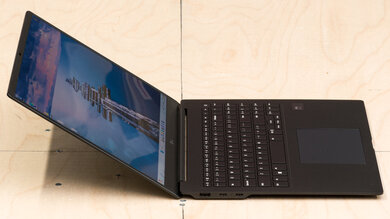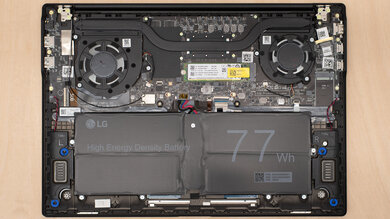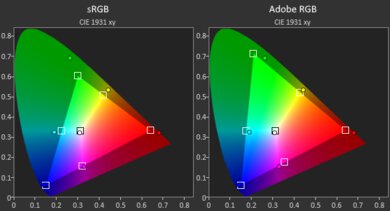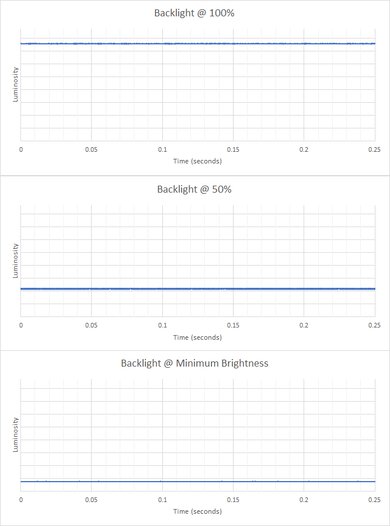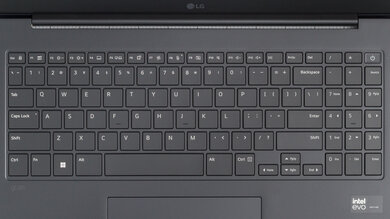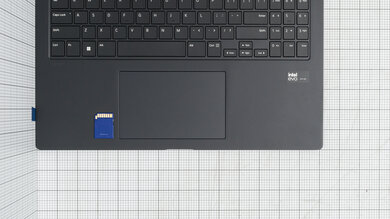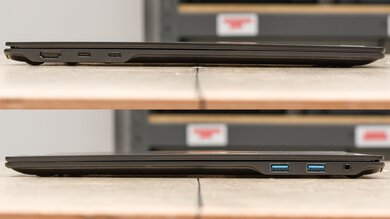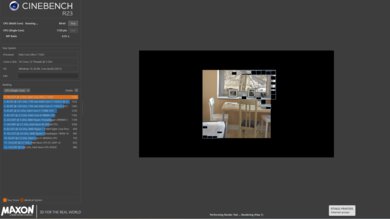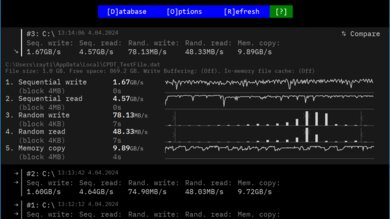The LG gram Pro 16 (2024) is a Windows ultraportable laptop. It's available with an Intel Core Ultra 5 or Ultra 7 CPU paired with Intel Arc integrated graphics only or an NVIDIA GeForce RTX 3050 discrete GPU. Memory and storage max out at 32GB and 1TB, respectively. Display options include a 144Hz QHD+ IPS and a 120Hz 2.8k OLED panel; both have full DCI P3 coverage and support LG's Various Refresh Rate to prolong battery life. It has Wi-Fi 6E wireless connectivity, a 1080p webcam, a facial recognition IR camera, and a 77Wh battery. Its port selection comprises two USB-As, two USB-C/Thunderbolt 4s, an HDMI, and a 3.5mm headphone jack.
See our unit's specifications and the available configuration options in the Differences Between Variants section.
Our Verdict
The LG gram Pro 16 is great for school use. It feels well-built, and it's incredibly thin and light for a 16-inch laptop, so it's easy to carry around. Its display provides plenty of room for multitasking and gets bright enough to combat glare in well-lit settings. The keyboard feels spacious, albeit slightly tiring to type on, and the touchpad is large and responsive. Performance isn't a problem for general productivity tasks; its Intel CPU and integrated graphics can easily handle text processing, web browsing, and video playback. You can do more intensive things on models with an Intel Core Ultra 7 CPU and RTX 3050 GPU, like 3D graphics and video editing, but you might encounter some slowdowns and stutters if the material is overly complex. Battery life is excellent at around 10 hours of light use, and there's a facial recognition IR camera for quick logins.
- Thin and light design.
- Battery lasts around 10 hours of light use.
- Core Ultra 7 CPU and RTX 3050 GPU can handle some demanding workloads.
- Sharp, bright display with full DCI P3 coverage.
- Large and responsive touchpad.
- Keyboard can be slightly tiring to type on for an extended period.
The LG gram Pro 16 isn't designed for gaming. You can only get this laptop with integrated graphics or an NVIDIA GeForce RTX 3050 Laptop GPU. The latter can handle games at 1080p, but you'll have to play with the lowest graphical settings and rely on NVIDIA's DLSS (when supported) to get playable frame rates. As for the display, you can choose between a 144Hz IPS or 120Hz OLED panel; neither supports FreeSync nor G-SYNC to reduce screen tearing. On the upside, it doesn't get hot or loud under load. LG gram Pro 16 isn't designed for gaming.
- Core Ultra 7/RTX 3050 models can handle some demanding games.
- Available with 144Hz IPS or 120Hz OLED display.
- Doesn't get hot or loud under load.
- User-replaceable storage slots.
- Available with integrated graphics only or a low-end RTX 3050.
- Soldered RAM.
- IPS display has slow response time.
- No FreeSync or G-SYNC support to reduce screen tearing.
- CPU throttles significantly under load.
The LG gram Pro 16 is decent for media consumption. It's easy to carry around, thanks to its thin and light design, and its battery lasts nearly ten hours of video playback, giving you enough time to get through a couple of full-length movies and TV show episodes. You can get the laptop with a QHD+ IPS or 2.8k OLED display; both look sharp and get bright enough for use in well-lit settings. The OLED display is also well suited for dark room viewing, as it can produce deep, inky blacks. The speakers get pretty loud but sound a tad unnatural, with only a small amount of bass.
- Thin and light design.
- Battery lasts around 10 hours of light use.
- Sharp, bright display with full DCI P3 coverage.
- Loud speakers.
- Speakers sound unnatural, with overly forward vocals.
- No touch input.
- IPS display isn't ideal for dark room viewing.
The LG gram Pro 16 is good for use as a workstation. You can get this laptop with up to an Intel Core Ultra 7 CPU and an NVIDIA GeForce RTX 3050 Laptop GPU, which are fast enough to handle some demanding tasks like video editing and 3D graphics. However, the CPU throttles significantly under load, and the RTX 3050 will struggle in highly demanding workloads, as it’s an entry-level GPU from NVIDIA's previous generation of GPUs. Also, you can only get up to 32GB of soldered RAM, which might not be enough for some people. You can do some color-correction work, though, as the available displays have full DCI P3 coverage. The SSD is user-replaceable, and there are tons of ports for peripherals and external displays, including two Thunderbolt 4s and an HDMI.
- Core Ultra 7 CPU and RTX 3050 GPU can handle some demanding workloads.
- Sharp, bright display with full DCI P3 coverage.
- Doesn't get hot or loud under load.
- User-replaceable storage slots.
- Thunderbolt 4 ports.
- Soldered RAM.
- CPU throttles significantly under load.
- Not enough processing power for highly demanding tasks.
The LG gram Pro 16 is great for business use. It's incredibly thin and light for a 16-inch laptop, and its battery lasts over 10 hours of light use, making it a great option for on-the-go use. It has a large display for split-screen multitasking, a spacious—albeit slightly tiring—full-size keyboard, a responsive touchpad, and a great 1080p webcam. Its Intel Meteor Lake CPU is more than adequate for productivity tasks like text processing, emails, spreadsheets, and presentations. You can even edit photos and videos, which is great for small business owners needing to do a bit of everything.
- Thin and light design.
- Battery lasts around 10 hours of light use.
- Sharp, bright display with full DCI P3 coverage.
- Large and responsive touchpad.
- Keyboard can be slightly tiring to type on for an extended period.
Changelog
-
Updated Aug 13, 2025:
Added mention of the ASUS Zenbook S 16 UM5606 (2024) as an alternative with better multi-thread performance in the Cinebench R23 section.
- Updated May 07, 2025: We've updated this review to Test Bench 0.8.3, which removes the viewing angle tests and adds a GPU Total Graphics Power comparison in the GPU section. The Pen Input test in the Extra Features section has also changed, as it now shows whether the laptop supports pen input rather than the inclusion of a stylus in the box. See the changelog for more details.
-
Updated Feb 17, 2025:
Added mention of the Lenovo Yoga Pro 9i 16 (2024) as an alternative available with more memory in the RAM section.
-
Updated Oct 21, 2024:
Added mention of the LG gram 16 (2024) as an alternative with longer battery life in the Battery section.
Check Price
Differences Between Sizes And Variants
We tested the LG gram Pro 16 (model 16Z90SP-G.AAB6U1) with a QHD+ IPS display, an Intel Core Ultra 7 155H CPU, integrated graphics, 16GB of RAM, and 1TB of storage. The display, CPU, GPU, memory, and storage are configurable; the available options are in the table below.
| Screen |
|
|---|---|
| CPU |
|
| GPU |
|
| Memory |
|
| Storage |
|
| Color |
|
See our unit's label here.
Popular Laptop Comparisons
The LG gram Pro is a good laptop overall. It has a sturdy build, a sharp, colorful display, an excellent touchpad, and all-day battery life. However, its performance is lacking, as its CPU throttles significantly under load, which isn't ideal for demanding work like video editing and 3D animation. Also, you can only get the laptop with integrated graphics or an NVIDIA GeForce RTX 3050, an aging, entry-level discrete GPU.
See our recommendations for the best business laptops, the best Windows laptops, and the best lightweight laptops.
The LG gram Pro 16 (2024) is slightly better than the LG gram 17 (2021) for most uses. The gram Pro 16 is available with much faster Intel Meteor Lake CPUs, and there’s also an NVIDIA GeForce RTX 3050 Laptop discrete GPU option to tackle more demanding tasks like video editing and 3D graphics. The gram Pro 16 is also smaller and lighter, making it easier to carry around. You can get the gram Pro 16 with a 144Hz QHD+ IPS or a 120Hz 2.8k OLED panel, whereas the gram 17 is only available with a 60Hz QHD+ IPS screen.
The LG gram Pro 16 (2024) and the LG gram 16 (2024) represent two tiers from LG's ultraportable product stack. The Pro model is better overall. The Pro model offers much better build quality; despite both models sharing the same design language and using the same magnesium alloy, it's more rigid, feels more durable, and picks up far fewer fingerprints during use. Our non-Pro unit came with a warped display assembly and had issues with gaping around the webcam module. The Pro model also has some options to help with the user experience, like a 2.8k OLED display. In terms of performance, the Pro model performs better despite sharing the same hardware. That said, if you need the longest battery life possible, the non-Pro gram offers vastly superior battery life than the Pro model, coming in at just over 15 hours for light use.
The LG gram 14 (2023) and the LG gram Pro 16 (2024) are both great Windows ultraportable. The gram Pro 16 is better overall; it has more processing power to handle demanding tasks, and it's available with sharper, brighter displays, including a 2.8k OLED panel. Also, its available displays have a high refresh rate (144Hz on the IPS and 120Hz on the OLED) to provide a smoother and more responsive desktop experience, whereas the gram 14's display is limited to 60Hz. However, the gram 14 has a better keyboard, as it has longer key travel and requires less force to actuate the keys. The gram 14 is more portable since it's a smaller device. That said, the gram Pro 16 isn't hard to carry around either, as it's incredibly thin and light for a 16-inch model.
The LG gram Pro 16 (2024) and ASUS Zenbook 14 OLED (2024) are both great Windows ultraportable laptops. Each has its pros and cons. The LG offers better performance with a discrete (albeit aging) GPU option, a superior thermal solution to help with sustained CPU loads, and better battery life. Despite its 16-inch size, the LG is extremely light and portable. However, if a 16-inch laptop is too big for you, the ASUS offers a smaller 14-inch form factor with features, making it a great choice for on-the-go general productivity use. To this end, it has a sturdier build and better webcam, and its OLED display supports touch and pen inputs.
Test Results

The LG gram Pro 16 is available in Black or White. See the bottom of the laptop here.
The LG gram Pro’s build quality is excellent. Its magnesium-alloy chassis feels quite sturdy but somewhat plasticky, which, combined with its lightweight design, can come off as being cheap, especially when compared to models with a full-aluminum chassis like the Apple MacBook Pro 16 (M3, 2023). The display twists a little when manipulating it, but not enough to be of concern, and there’s very little flex on the lid and keyboard deck. The finish doesn’t scratch easily, and surprisingly, the dark color model doesn’t pick up many fingerprints.
The LG gram Pro’s serviceability is mediocre. Accessing the internals is relatively easy; you need to remove the feet (not glued on) and four Philips screws, then undo the clips holding the bottom panel. You might need a prying tool, as the clips are somewhat challenging to undo. Both storage slots support M.2 2280 PCIe Gen 4 NVMe SSDs.
Get the online manual here.
The LG gram Pro 16 is available with the following displays:
- 16" IPS 2560 x 1600 144Hz (matte)
- 16" OLED 2880 x 1800 120Hz (glossy)
Both displays look very sharp and provide plenty of space for split-screen multitasking. The 2.8k OLED display is technically sharper (212 PPI), but the difference is hard to notice at typical viewing distances. Both are 16:10 displays. This aspect ratio is great for productivity, as you get slightly more vertical space than a standard 16:9 display, allowing you to see more information when reading a document or website. The OLED display is susceptible to permanent burn-in, especially with static elements like Windows' taskbar; however, it's unlikely to be an issue for those viewing varied content.
The QHD+ display has a high refresh rate to provide a more responsive desktop experience; however, its response time is quite slow, resulting in noticeable ghosting behind fast-moving objects. The OLED display has a slightly lower refresh rate of 120Hz but likely a much faster response time, as the response time on OLED panels is typically near-instantaneous. Both displays support LG’s Various Refresh Rate, a power-conservation feature similar to Windows’ Dynamic Refresh Rate and Apple’s ProMotion. This means it can change the refresh rate (between 33Hz and 144Hz) depending on what you’re doing and whether you have the laptop plugged in. Note that Various Refresh Rate isn’t the same as FreeSync and G-SYNC, so you’ll still see tearing when gaming with an uncapped frame rate.
The QHD+ display's contrast ratio is good and within the typical range for most IPS panels. However, it's still relatively low compared to other display technologies like VA and OLED. This contrast level makes blacks look gray in dim settings. The OLED display has effectively an infinite contrast ratio since it can turn off individual pixels to produce perfect blacks, making it a much better option for dark room viewing.
The QHD+ display gets bright enough for use in most indoor environments. Outdoor use is possible, but you may have trouble seeing dark-color content on bright, sunny days or in direct sunlight. As for the OLED panel, although it has the same advertised brightness of 400 cd/m², remember that it has a glossy finish, so you'll likely get more distracting reflections, even with the screen at max brightness. The screen gets very dim at the lowest brightness setting, which helps reduce eye strain when viewing content in the dark.
The QHD+ display's reflection handling is decent. Viewing light-color content isn't a problem because the screen gets bright enough to compensate; it's mostly dark-color content that'll be hard to see. The 2.8k OLED panel has a glossy finish and will likely struggle more with direct, mirror-like reflections.
The QHD+ display's accuracy is passable out of the box. The white balance inaccuracies are relatively minor except at higher brightness levels where there's too much blue. There's a good amount of oversaturation when it comes to the colors. Some people might like this oversaturated look; it just isn't accurate. The color temperature is on the cooler side, giving the image a blueish tint, and the gamma sticks to an almost flat 2.2, making dark scenes too dark and bright scenes too bright.
The LG Smart Assistant app has a few display-related settings, including a Professional Mode, which supposedly lets users access a wider color gamut for content creation work; however, it doesn't seem to have much effect. Here are the accuracy results and the color gamut measurements with it enabled.
The QHD+ IPS display's color gamut is outstanding. It has full sRGB and DCI P3 coverage, making it suitable for media consumption and content creation. Its Adobe RGB coverage is excellent, though it may not be good enough for professional print photography, as it can't reproduce the highly saturated greens that define Adobe RGB. The 2.8k OLED display has the same color gamut.
The LG gram Pro has a decent keyboard. It feels spacious and sports flat keycaps with a light, almost imperceptible texture. There isn't anything particularly weird about the layout, but it might still take some time to get used to, especially if you aren't accustomed to a full-size keyboard with a numpad. The keys provide good tactile feedback; however, they don't have much travel and require a fair amount of force to actuate, which can cause some fatigue over time. The backlighting is white, leaning on the cooler side.
The LG gram Pro has an excellent touchpad. It's large, smooth, and responsive to all movements and gestures. Palm rejection is okay for the most part, though you might get a few unintentional triggers once in a while. The buttons feel tactile but only work in the bottom half of the touchpad.
The LG gram Pro 16's speakers get pretty loud with minimal compression or distortion at higher volume levels. Sound-wise, they emphasize vocals quite a bit, almost to the point of drowning out other instruments. They also sound a tad unnatural. There's some bass, but not a whole lot.
The LG gram Pro has a good webcam. The image looks detailed and well-exposed, but also slightly noisy, with a somewhat unnatural saturation boost to some colors. Voices sound loud and clear over the microphone, with little to no static or background noise.
The LG gram Pro has an outstanding port selection. Both USB-A ports support USB 3.2 Gen 1 data transfer speed of up to 5Gbps. The two USB-C ports support Thunderbolt 4 (up to 40Gbps data transfer speed and two 4k @ 60Hz displays), USB 3.2 Gen 2, and Power Delivery. The latter lets you fast charge the laptop and other PD-compatible devices connected to the port.
The LG gram Pro's wireless adapter is an Intel Wi-Fi 6E AX211.
The LG gram Pro 16 is available with the following CPUs:
- Intel Core Ultra 5 125H (14 cores, 18 Threads, up to 4.5 GHz, 18MB Cache)
- Intel Core Ultra 7 155H (16 cores, 22 Threads, up to 4.8 GHz, 24MB Cache)
Both are high-performance CPUs from Intel's Meteor Lake family. Unlike Intel's 14th Gen processors (13th Gen Raptor Lake refreshes), these CPUs have two low-power E-cores (LP-E) to further improve efficiency and an NPU (Neural Processing Units) to handle AI-based tasks, like background-blurring on video calls and some functions in photo editing apps. These processors can easily handle general productivity tasks, like text processing, web browsing, video playback, spreadsheets, and presentations. You can perform more demanding tasks like programming and video editing, though the experience won't be as smooth as on a laptop with a higher wattage CPU, like the Dell Alienware m18 R2 (2024), and tasks will take longer to complete. Regarding core composition, the Core Ultra 5 has four performance cores, eight efficiency cores, and two low-power efficiency cores (4P+8E+2LP-E), while the Core Ultra 7 has six performance cores, eight efficiency cores, and two low-power efficiency cores (6P+8E+2LP-E). Both CPUs have the same Neural Processing Units (NPU).
The LG gram Pro is available only with Intel Arc graphics (integrated) or an NVIDIA GeForce RTX 3050 Laptop GPU (discrete). While better than Iris Xe, Intel's Arc integrated GPU is still a low-power graphics processor designed for general productivity tasks, not demanding workloads like gaming and 3D graphics. The NVIDIA GeForce RTX 3050 Laptop GPU is better and can handle some intensive tasks, but don't expect too much of it, as it's an aging, entry-level GPU with only 4GB of VRAM. Although LG doesn't specify the TGP (Total Graphics Power), it's likely at or near the minimum 35W, considering the chassis size and the included 90W power adapter. In other words, it'll get the job done, but you might experience slowdowns or stutters if the material is overly complex. Check out the Lenovo ThinkPad P1 Gen 7 (2024) if you want a laptop with more powerful GPU options.
You can configure this laptop with 8GB, 16GB, or 32GB of RAM. The memory isn't user-replaceable. Check out the Lenovo Yoga Pro 9i 16 (2024) if you need a laptop available with more memory.
You can configure the LG gram Pro with 256GB, 512GB, or 1TB of storage. The SSD is user-replaceable. There are two slots; both support M.2 2280 PCIe Gen 4 NVMe SSDs.
The LG gram Pro has an outstanding overall score in Geekbench 5. The Intel Core Ultra 7 155H CPU performs well in a variety of workloads and can easily handle general productivity tasks like web browsing, text processing, and video playback. You can run more intensive, multi-threaded applications; however, you might experience some stutters and slowdowns if the work is overly complex. Also, the CPU throttles a lot after 10 or 15 minutes of heavy, sustained load, so you'll see a dramatically longer completion time. If you have a demanding workload, you're better off getting a laptop with a faster processor, like the Intel Core i9-14900HX in the Dell Alienware m18 R2 (2024) or Apple's M3 Pro/Max SoCs in the Apple MacBook Pro 14 (M3, 2023) and Apple MacBook Pro 16 (M3, 2023), paired with a superior cooling system. As for GPU computing tasks, the Intel Arc integrated GPU isn't suitable for such workloads, but the NVIDIA GeForce RTX 3050 is. That said, the 3050 is an entry-level GPU, and it likely runs at a low wattage, so don't expect to have the smoothest experience or the fastest completion times.
The LG gram Pro 16's Intel Core Ultra 7 155H CPU scores well in the Cinebench R23 benchmarks. It can handle heavy multitasking and intensive, multi-threaded applications. However, this laptop still isn't ideal for workloads that put the CPU under load for more than 10 to 15 minutes at a time, as the processor throttles significantly at that point, leading to a much longer completion time. The Core Ultra 5 125H is slower and only suitable for general productivity tasks. Check out the ASUS Zenbook S 16 UM5606 (2024) if you need a laptop with better multi-thread performance.
You can do 3D graphics work in Blender on the LG gram Pro 16, but it's best to get a model with an NVIDIA GeForce RTX 3050, as this discrete GPU will provide a smoother experience and render images in significantly less time than the CPU.
The Basemark GPU score is mediocre. Intel's Arc integrated GPU is certainly better than the older Iris Xe and even beats AMD's Radeon 780M, but it's slower than Apple's base M3 SoC and doesn't even come close to the performance of an entry-level discrete GPU like the NVIDIA GeForce GTX 1650. You can play some light, older games, but only with low graphical settings. The NVIDIA GeForce RTX 3050 performs better and can handle some demanding games at 1080p, but again, you'll have to play with low settings to get playable frame rates.
Models with a 2.8k OLED display and/or NVIDIA GeForce RTX 3050 Laptop GPU likely have a shorter battery life. If you're chasing after longer battery life, consider the LG gram 16 (2024).
Borderlands 3 runs poorly on the LG gram Pro. The Intel Arc integrated graphics can't handle such a demanding game. Models with an NVIDIA GeForce RTX 3050 Laptop GPU will fare better and get you closer to 60 fps; however, you'll have to play at 720p or with the lowest graphical settings, and even then, you might still experience a lot of stutters.
Civilization VI is playable on models with Intel Arc graphics with medium to low settings. You'll still experience stutters, but they aren't game-breaking since it's a strategy game that doesn't require precise aiming or fast reaction time. Models with an NVIDIA RTX 3050 will have no issues running this game.
Counter-Strike 2 runs poorly. The Intel Arc GPU can push over 60 fps with low settings, but the gameplay is still choppy due to frame drops. This game will likely run well on models with an NVIDIA RTX 3050 GPU with minimal tweaks in the settings.
Shadow of the Tomb Raider runs poorly on the LG gram Pro. The gameplay is extremely choppy, even with the lowest graphical settings. Models with an RTX 3050 discrete GPU will perform better and get you closer to 60 fps, but you'll have to play with relatively low settings and rely on DLSS to get there.
The keyboard gets a little toasty under load but isn't uncomfortable by any means. The fans are barely audible. You can change the fan profile via the LG Smart Assistant app.
The LG gram Pro 16 has many pre-installed applications, including:
- Intel Unison: Lets you connect your smartphone to the laptop, allowing you to send and receive messages, view photos on your smartphone, and transfer files, similar to the MyPhone app.
- LG Glance by Mirametrix: Software application that adds attention-sensing capability. When enabled, it can automatically lock your computer when you walk away, pause a video or blur the content when you aren't directly looking at the screen, or move windows from one screen to another.
- LG gram Link: Lets you link your smartphone with the PC. You can use it to transfer files, use your smartphone as a second display, or mirror your phone's content.
- LG On Screen Display 3: Adds an overlay that informs of any changes, like whether Caps Lock is on or off.
- LG PC manuals: User manual.
- LG Security Guard: Monitors suspicious activities when the user is away from the laptop.
- LG Smart Assistant 2.0: Lets you change the fan and power settings, enable dark mode, toggle USB-C offline charging, and enable AI noise canceling.
- LG Update: Checks for software and driver updates.
- Solitaire & Casual Games: Solitaire, FreeCell, Spider, Mahjong, Sudoku, and other casual games.
- Spotify Music: App for the music streaming service.



